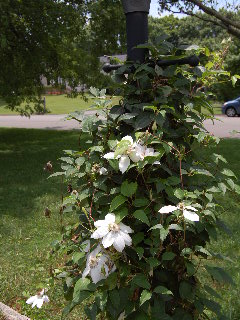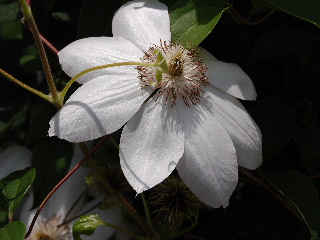
One of the gardener’s favorite vining plants, clematis is famous for producing a profusion of blooms all summer long.
Clematis has a bit of a bad reputation as a temperamental plant to grow. However, with proper selection, planting and care, the average gardener can cultivate and maintain a beautiful and hardy climbing clematis vine for decades! These plants, if well-tended can be extremely long-lived.
My first suggestion would be to order clematis plants from a reputable nursery. Be sure the varieties you select are acclimated for cultivation in your growing zone. In general, clematis is adaptable to the greater portion of the U.S., being unable to survive in only the coldest or hottest regions.
One of the most popular varieties to consider is Clematis Jackmanii, which produces large (up to 4 or 5 inches across) brilliant purple blooms in profusion all during the warm summer months. It makes a spectacular showing when trained up a trellis or properly supported in some way that allows maximum sunlight to reach the foliage.
Take great care in planting your clematis. Select a well-drained site that will receive sunlight throughout most of the day. Also, when selecting your planting site, give consideration as to how your plant will be supported as it grows—on the mailbox post, clinging to a free-standing trellis, or anchored to the side of the house.
When preparing the hole for your clematis, dig at least twice as deep and twice as wide as the root ball you will be planting. Carefully remove the clematis from its container (sometimes, it’s best to use snips to cut the container away from the plant) so as not to damage the root system.
Set the clematis into the prepared hole so that its original ground surface level is about 3 inches below the new ground surface level. As you backfill around the roots, you will then be adding new soil a few inches up around the stem. This is okay, and will encourage bud production below the ground level. This method also protects the roots and helps keep them cool and moist. A layer of mulch is also a good idea.

A general rule for growing clematis is to keep the roots cool and shaded and to keep the foliage in the sunlight.
As for pruning, clematis that flowers in the spring is producing blooms from last year’s growth; prune soon after flowering so as not to remove future bloom buds.
Another type of clematis produces some flowers from the previous year’s growth and some from the current year’s growth. Prune selectively so as to encourage flowering on the biggest and healthiest looking buds.
A third type of clematis produces blooms on the current year’s growth; these flowers usually appear later into the summer and fall rather than on the spring growth. This type of clematis can be cut back severely to a height of just a couple of feet very early in the year before new growth has started.
The trick is to know what you’ve got in order to know how to properly care for your particular variety of clematis. So……we’ve come full circle back to the beginning advice of ordering from a reliable supplier who will make you aware of the cultural requirements of the species of clematis you are receiving.
With just a minimum of effort on your part, clematis can become one of the most beautiful additions to your garden.
 One of the gardener’s favorite vining plants, clematis is famous for producing a profusion of blooms all summer long.
One of the gardener’s favorite vining plants, clematis is famous for producing a profusion of blooms all summer long.
 A general rule for growing clematis is to keep the roots cool and shaded and to keep the foliage in the sunlight.
A general rule for growing clematis is to keep the roots cool and shaded and to keep the foliage in the sunlight.